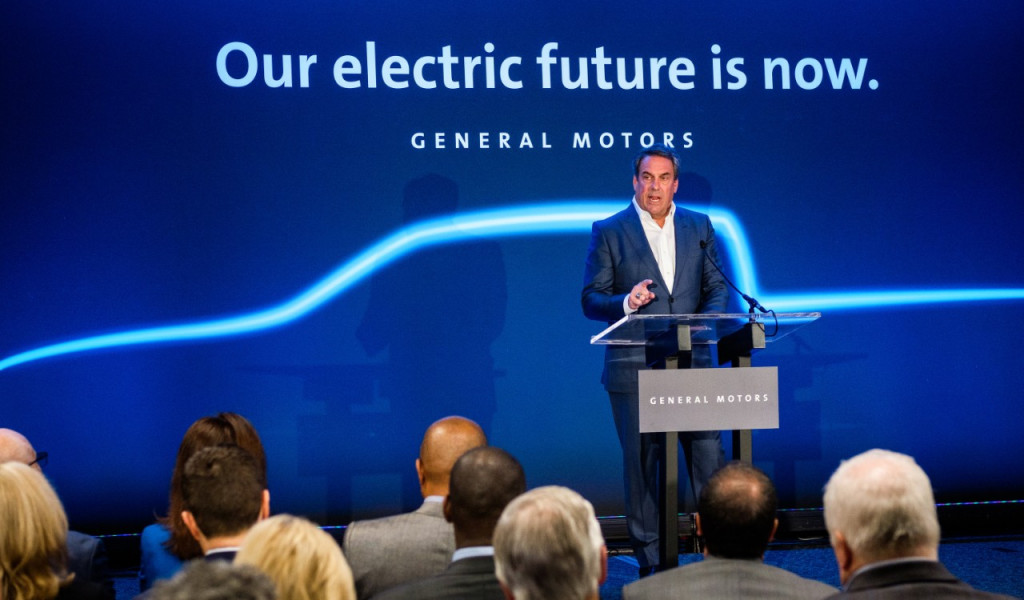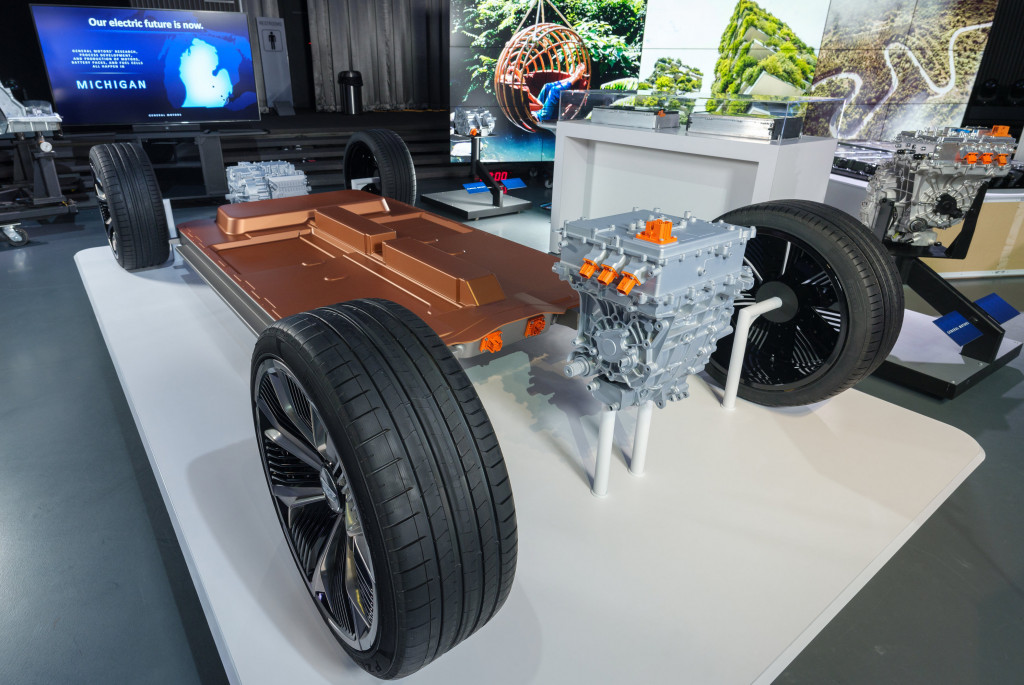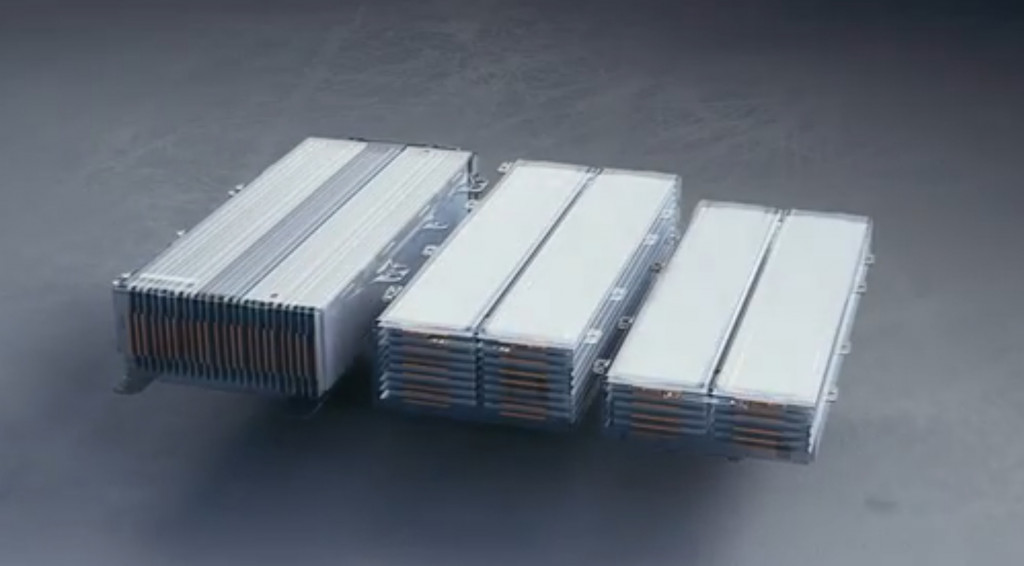In fall 2021, GM will bring back Hummer—a brand once maligned by environmentalists—with a set of zero-tailpipe-emissions electric vehicles aimed at weekend adventurers.
With that timing, 2022 GMC Hummer EV models will likely arrive after the Rivian R1T and R1S but before the Tesla Cybertruck—as well as a long list of other electric-truck models, including a fully electric Ford F-150.
So far the company has only teased a few details. GM was originally planning to reveal the GMC Hummer trucks on May 20, but the coronavirus crisis canceled that physical event and the automaker hasn’t yet set a date for an expected virtual reveal this fall.
The delay for the Hummer EVs’ curtain bow won’t affect their rollout on the market, GM has insisted at several points, citing “little or no impact” from the pandemic-induced slowdown—although it did delay the refresh of its Bolt EV by a model year.

GM president Mark Reuss announcing Detroit-Hamtramck EV investment
After many months of reports suggesting a Hummer return was being considered, GM confirmed the vehicle three days before a Super Bowl ad, noting that the truck will have a maximum power of 735 kilowatts (1,000 horsepower) and teased a 3.0-second 0-60 mph acceleration time. It also claimed up to 11,500 foot-pounds of torque—a mostly meaningless figure, as it’s likely wheel torque as multiplied through reduction gearing.
The Hummer SUT combines a roomy cabin—along the lines of a crew cab—with a modestly sized pickup bed. The GMC Hummer SUV is essentially the same vehicle from the side pillar forward, but it has a tall body that, at least at a quick look, appeared to be built with a somewhat shorter overall length (and perhaps, a shorter wheelbase). Overall, the Hummer models appear sized at the small end of today’s full-size pickups and SUVs, but GM has resisted confirming anything about dimensions.
Among the ten or so upcoming electric vehicles that Green Car Reports saw in a private, no-cameras reveal earlier this year, the Hummer models were among the best-coordinated between their interior and exterior styling, as the same close team had worked on these trucks.
The styling mixes chunky proportions with some amount of body sculpting and creasing—essentially picking up where Hummer left off with the brand’s discontinuation in 2009, rather than reaching back to the blocky Hummer H1 that started it all in the 1990s for inspiration. Designers might have decided it’s too early to consider that retro, but the story of why the trucks look like they do will likely not be told until the reveal.
Removable roof panels (above) are one of the distinct features in the Hummer EV models, and when removed have no connection between the windshield header and roof structure. Top models in the lineup will also have a four-corner air suspension with multiple ride heights and capability modes.
The Hummer SUV and SUT will be among the first few vehicles to be built on GM’s Ultium propulsion system and what it’s also termed to be BEV3 underpinnings. The GMC Hummer EV models are built with a body-on-frame approach that, GM has emphasized, is different than the skateboard layout some other EV makers are using—and allows its trucks to share some of the same components with unibody cars and crossovers.

General Motors' BEV3 platform and Ultium batteries
As GM officials confirmed, the GM Hummer models will show off the upper end of the strategy’s potential in power and range. The Hummer EVs are expected to have three motors (two in back), with battery packs for these trucks to range up to 200 kilowatt-hours—potentially among the largest on the market, incorporating GM’s “double stack” pack.
The trucks, at least in some future versions, might be capable of 350-kw DC fast charging, with a possible EPA range of up to 400 miles.

GM Ultium battery - cell stacking
The Hummer EVs will be made in GM’s Detroit-Hamtramck plant, and the large-format cells co-developed between GM and LG Chem will be made at an Ohio plant.
With the expansion in the availability of GM Super Cruise from Cadillac models to the upcoming Chevrolet Bolt EUV, don’t be surprised to see it also available from the start in the GMC Hummer EV models.
It’s likely that the introduction of the Hummer EV will be an occasion to get more information from GM on all the clinicking that must have gone on behind the scenes at the automaker leading up to the decision.
Would you support GM bringing Hummer back as an EV-exclusive brand?
— Green Car Reports (@GreenCarReports) June 18, 2019
In a Twitter poll of our readers last year, when news first emerged that GM was at least considering the move, only 39% of respondents were solidly behind bringing the brand back all-electric. The remaining 61% were either reluctantly okay with the idea because it enables more EVs, or reacted strongly against reviving the name.
Outside of Hummer’s image of excess gone awry, its heritage as a symbol of the war for oil has always been a bold statement. But perhaps that makes Hummer the perfect warrior for the green-energy revolution.
What do you think? Stay tuned as we learn more and update this page.
